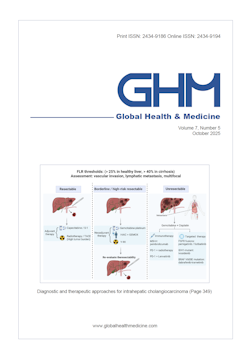Global Health & Medicine 2023;5(1):33-39.
Evaluation of a bundle approach for the prophylaxis of ventilatorassociated pneumonia: A retrospective single-center Study
Sekihara K, Okamoto T, Shibasaki T, Matsuda W, Funai K, Yonehiro Y, Matsubara C, Kimura A
Ventilator-associated pneumonia (VAP) is defined as pneumonia occurring after the first 48 hours of intubation and mechanical ventilation and is the most frequent hospital-acquired infection associated with intensive care unit (ICU) admissions. Herein, we defined a novel VAP bundle including 10 preventive items. We analyzed compliance rates and clinical effectiveness associated with this bundle in patients undergoing intubation at our medical center. A total of 684 consecutive patients who underwent mechanical ventilation were admitted to the ICU between June 2018 and December 2020. VAP was diagnosed by at least two physicians based on the relevant United States Centers for Disease Control and Prevention criteria. We retrospectively evaluated associations between compliance and VAP incidence. The overall compliance rate was 77%, and compliance generally remained steady during the observation period. Moreover, although the number of ventilatory days remained unchanged, the incidence of VAP improved statistically significantly over time. Low compliance was identified in four categories: head-of-bed elevation of 30- 45º, avoidance of oversedation, daily assessment for extubation, and early ambulation and rehabilitation. The incidence of VAP was lower in those with an overall compliance rate of ≥ 75% than its incidence in the lower compliance group (15.8 vs. 24.1%, p = 0.018). When comparing low-compliance items between these groups, we found a statistically significant difference only for daily assessment for extubation (8.3 vs. 25.9%, p = 0.011). In conclusion, the evaluated bundle approach is effective for the prophylaxis of VAP and is thus eligible for inclusion in the Sustainable Development Goals.
DOI: 10.35772/ghm.2022.01038







